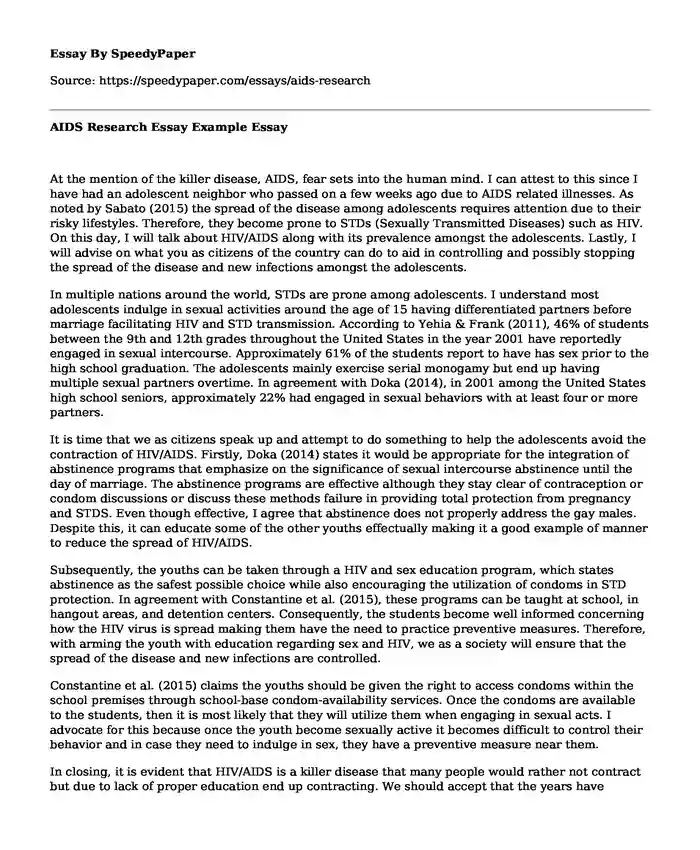
| Type of paper: | Essay |
| Categories: | Health and Social Care HIV |
| Pages: | 3 |
| Wordcount: | 687 words |
At the mention of the killer disease, AIDS, fear sets into the human mind. I can attest to this since I have had an adolescent neighbor who passed on a few weeks ago due to AIDS related illnesses. As noted by Sabato (2015) the spread of the disease among adolescents requires attention due to their risky lifestyles. Therefore, they become prone to STDs (Sexually Transmitted Diseases) such as HIV. On this day, I will talk about HIV/AIDS along with its prevalence amongst the adolescents. Lastly, I will advise on what you as citizens of the country can do to aid in controlling and possibly stopping the spread of the disease and new infections amongst the adolescents.
In multiple nations around the world, STDs are prone among adolescents. I understand most adolescents indulge in sexual activities around the age of 15 having differentiated partners before marriage facilitating HIV and STD transmission. According to Yehia & Frank (2011), 46% of students between the 9th and 12th grades throughout the United States in the year 2001 have reportedly engaged in sexual intercourse. Approximately 61% of the students report to have has sex prior to the high school graduation. The adolescents mainly exercise serial monogamy but end up having multiple sexual partners overtime. In agreement with Doka (2014), in 2001 among the United States high school seniors, approximately 22% had engaged in sexual behaviors with at least four or more partners.
It is time that we as citizens speak up and attempt to do something to help the adolescents avoid the contraction of HIV/AIDS. Firstly, Doka (2014) states it would be appropriate for the integration of abstinence programs that emphasize on the significance of sexual intercourse abstinence until the day of marriage. The abstinence programs are effective although they stay clear of contraception or condom discussions or discuss these methods failure in providing total protection from pregnancy and STDS. Even though effective, I agree that abstinence does not properly address the gay males. Despite this, it can educate some of the other youths effectually making it a good example of manner to reduce the spread of HIV/AIDS.
Subsequently, the youths can be taken through a HIV and sex education program, which states abstinence as the safest possible choice while also encouraging the utilization of condoms in STD protection. In agreement with Constantine et al. (2015), these programs can be taught at school, in hangout areas, and detention centers. Consequently, the students become well informed concerning how the HIV virus is spread making them have the need to practice preventive measures. Therefore, with arming the youth with education regarding sex and HIV, we as a society will ensure that the spread of the disease and new infections are controlled.
Constantine et al. (2015) claims the youths should be given the right to access condoms within the school premises through school-base condom-availability services. Once the condoms are available to the students, then it is most likely that they will utilize them when engaging in sexual acts. I advocate for this because once the youth become sexually active it becomes difficult to control their behavior and in case they need to indulge in sex, they have a preventive measure near them.
In closing, it is evident that HIV/AIDS is a killer disease that many people would rather not contract but due to lack of proper education end up contracting. We should accept that the years have changed with more youths indulging in sex making it up to the society to ensure the adolescents are educated and stay aware from contracting the disease.
References
Doka, K. J. (2014). AIDS, Fear and Society : Challenging the Dreaded Disease. London: Taylor & Francis
Sabato, D. T. (2015). HIV in Young Adults: An Exploration of Knowledge and Risk. College Student Journal, 49(3), 427-437
Constantine, N. A., Jerman, P., Berglas, N. F., Angulo-Olaiz, F., Chih-Ping, C., & Rohrbach, L. A. (2015). Short-term effects of a rights-based sexuality education curriculum for high-school students: a cluster-randomized trial. BMC Public Health, 15(1), 1-13. doi:10.1186/s12889-015-1625-5
Yehia, B., & Frank, I. (2011). Battling AIDS in America: An Evaluation of the National HIV/AIDS Strategy. American Journal Of Public Health, 101(9), e4-e8
Cite this page
AIDS Research Essay Example. (2019, Jun 10). Retrieved from https://speedypaper.net/essays/aids-research
Request Removal
If you are the original author of this essay and no longer wish to have it published on the SpeedyPaper website, please click below to request its removal:
- Free Essay Example: Local Knowledge Methodology vs Scientific Knowledge
- Essay Example on a Health System That Keeps Us Healthy
- Personal Reflection Essay Sample on the Article: Commodified Agents and Empowered Girl
- Law Essay Example: Storey Versus Commissioner
- Research Paper Example on Spelling and Writing Quality
- Paper Example on Domestic Violence by Eavan Boland
- Essay Sample on Measuring TQM Performance
Popular categories




